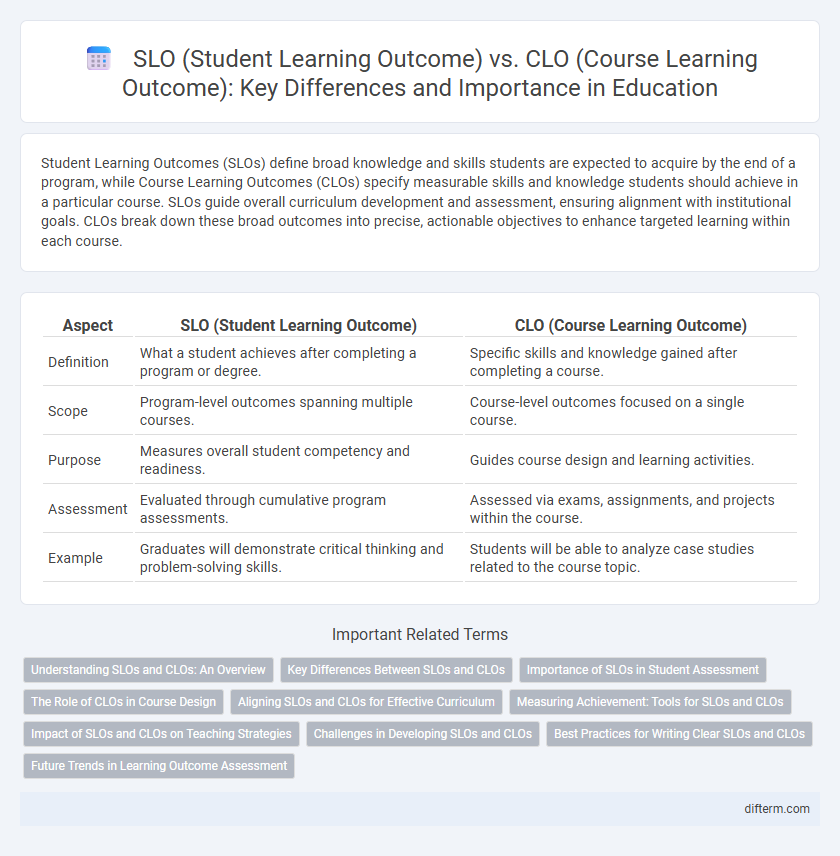Student Learning Outcomes (SLOs) define broad knowledge and skills students are expected to acquire by the end of a program, while Course Learning Outcomes (CLOs) specify measurable skills and knowledge students should achieve in a particular course. SLOs guide overall curriculum development and assessment, ensuring alignment with institutional goals. CLOs break down these broad outcomes into precise, actionable objectives to enhance targeted learning within each course.
Table of Comparison
| Aspect | SLO (Student Learning Outcome) | CLO (Course Learning Outcome) |
|---|---|---|
| Definition | What a student achieves after completing a program or degree. | Specific skills and knowledge gained after completing a course. |
| Scope | Program-level outcomes spanning multiple courses. | Course-level outcomes focused on a single course. |
| Purpose | Measures overall student competency and readiness. | Guides course design and learning activities. |
| Assessment | Evaluated through cumulative program assessments. | Assessed via exams, assignments, and projects within the course. |
| Example | Graduates will demonstrate critical thinking and problem-solving skills. | Students will be able to analyze case studies related to the course topic. |
Understanding SLOs and CLOs: An Overview
Student Learning Outcomes (SLOs) define the broad skills and knowledge students are expected to acquire by the end of an educational program, providing a framework for overall academic achievement. Course Learning Outcomes (CLOs) specify the targeted competencies students should demonstrate after completing a particular course, aligning with the broader program-level SLOs. Understanding the relationship between SLOs and CLOs is crucial for curriculum design, assessment strategies, and ensuring coherent educational objectives across multiple course levels.
Key Differences Between SLOs and CLOs
Student Learning Outcomes (SLOs) focus on the overall knowledge, skills, and attitudes students are expected to demonstrate after completing a program, providing a broad measure of educational effectiveness. Course Learning Outcomes (CLOs) specify the precise competencies and achievements students should attain by the end of a particular course, aligning directly with course content and instructional objectives. The key difference lies in the scope and application: SLOs address program-level goals, while CLOs target specific course-level achievements.
Importance of SLOs in Student Assessment
Student Learning Outcomes (SLOs) provide a comprehensive measure of a learner's overall knowledge, skills, and attitudes acquired throughout an educational program, forming the basis for effective student assessment. SLOs guide curriculum design and assessment strategies by clearly defining the expected competencies, enabling educators to evaluate student performance against holistic educational goals. The alignment of assessments with SLOs ensures valid, reliable, and meaningful evaluation of student progress, enhancing academic accountability and continuous improvement.
The Role of CLOs in Course Design
Course Learning Outcomes (CLOs) play a critical role in course design by clearly defining the specific knowledge, skills, and attitudes students are expected to achieve upon completing a course. CLOs guide instructors in structuring content, assessments, and instructional activities to ensure alignment with desired competencies and overall program goals. Effective CLOs facilitate measurable evaluation of student progress and enhance curriculum coherence within educational programs.
Aligning SLOs and CLOs for Effective Curriculum
Aligning Student Learning Outcomes (SLOs) with Course Learning Outcomes (CLOs) ensures a coherent and targeted educational pathway, enhancing curriculum effectiveness by directly linking course objectives to overarching program goals. Precision in mapping CLOs to SLOs facilitates measurable assessment strategies and supports continuous improvement in teaching methodologies. This alignment promotes student competency development, enabling institutions to meet accreditation standards and improve academic success rates.
Measuring Achievement: Tools for SLOs and CLOs
Measuring achievement for Student Learning Outcomes (SLOs) and Course Learning Outcomes (CLOs) involves distinct assessment tools tailored to their scope, with SLOs often assessed through standardized exams, surveys, and performance tasks that evaluate overall competency development across programs. CLOs require more specific, course-level assessments such as quizzes, assignments, projects, and direct observations aligned with targeted knowledge and skills within a single course. Both require rubrics and data analysis to quantify achievement effectively, ensuring alignment with curriculum goals and facilitating continuous improvement in educational quality.
Impact of SLOs and CLOs on Teaching Strategies
SLOs and CLOs provide targeted frameworks that shape teaching strategies by aligning instructional methods with specific learning goals. Incorporating SLOs helps educators customize pedagogy to broader student development, while CLOs enable focused content delivery and assessment within courses. This dual emphasis enhances curriculum coherence, improves student engagement, and fosters measurable academic achievement.
Challenges in Developing SLOs and CLOs
Challenges in developing Student Learning Outcomes (SLOs) and Course Learning Outcomes (CLOs) often include aligning outcomes with institutional goals while ensuring they are measurable and specific. Educators face difficulties in balancing broad skill development with precise, assessable criteria that reflect both course content and overall student progress. Furthermore, discrepancies in interpretation among faculty can lead to inconsistent application and assessment of these learning outcomes.
Best Practices for Writing Clear SLOs and CLOs
Effective SLOs and CLOs must be specific, measurable, and aligned with institutional goals to accurately assess student achievement and course effectiveness. Best practices include using action verbs from Bloom's Taxonomy, ensuring outcomes are student-centered, and providing clear criteria for performance evaluation. Consistent review and refinement of these outcomes based on feedback and assessment data drive continuous improvement in educational quality.
Future Trends in Learning Outcome Assessment
Emerging trends in learning outcome assessments highlight the integration of advanced analytics and AI-driven tools to evaluate both Student Learning Outcomes (SLOs) and Course Learning Outcomes (CLOs) with greater precision. Adaptive learning technologies facilitate real-time data collection on CLO achievement, enabling educators to tailor instructional strategies that improve SLO attainment. The shift towards competency-based education emphasizes measurable outcomes, fostering alignment between institutional goals and individual learner progress through sophisticated assessment frameworks.
SLO (Student Learning Outcome) vs CLO (Course Learning Outcome) Infographic

 difterm.com
difterm.com